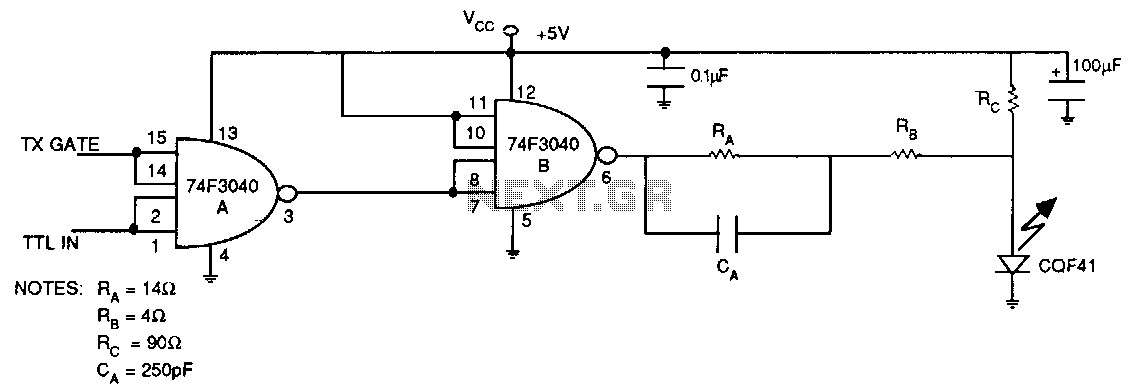
Fiber-optic-led-driver

The pull-up transistor of the totem-pole output is used to turn on the LED, while the pull-down transistor is used to turn off the LED. The lower impedance and higher current handling capability of the saturated pull-down transistor serve as an effective method for transferring the charge from the LED's anode to ground, as its dynamic resistance increases during turn-off. The slightly higher output impedance of the pull-up stage ensures that the LED is not over-driven during the less demanding turn-on transition. This asymmetric current handling capability of the output stage, along with its variable impedance, significantly reduces pulse-width distortion and long-tailed response. As the signal propagates through two NAND gates, each transition passes through the high-to-low and low-to-high transitions once, normalizing the total propagation delay throughout the circuit.
The described circuit utilizes a totem-pole output configuration, which is a common design in digital electronics for driving loads such as LEDs. The pull-up transistor is responsible for sourcing current to the LED when it is activated, while the pull-down transistor sinks the current when the LED is deactivated. This arrangement allows for efficient control of the LED's illumination state.
The pull-down transistor, when saturated, presents a low impedance path to ground, facilitating rapid discharge of the capacitor formed by the LED's junction capacitance. This characteristic is essential for achieving fast turn-off times, minimizing the risk of unwanted illumination and reducing power dissipation during the off state. As the pull-down transistor transitions out of saturation, its dynamic resistance increases, effectively limiting the current flowing through the LED and preventing it from being over-driven.
Conversely, the pull-up transistor functions to limit the current during the turn-on phase. Its slightly higher output impedance mitigates the risk of excessive current surging through the LED, which could lead to thermal stress and premature failure. This balanced approach to current handling ensures that the LED operates within safe parameters throughout its lifecycle.
The circuit further benefits from the propagation characteristics of the two NAND gates. Each gate introduces a transition delay that is symmetrical for both high-to-low and low-to-high transitions. This normalization of propagation delay is critical in high-speed applications, as it helps maintain signal integrity and reduces jitter. By ensuring that the transitions are consistent, the circuit can operate effectively in digital systems where timing is crucial.
Overall, the design emphasizes efficiency and reliability in LED control, utilizing advanced transistor characteristics and careful arrangement of logic gates to achieve optimal performance.The pull-up transistor of the totem-pole output is used-to turn on the LED and the pull-down transistor is used to turn ·off the LED. The lower impedance and higher current handling capability of the saturated pull-down transistor is used as an effective method of transferring the charge from the LED"s anode to ground as its dynamic resistance increases during turn-off.
The slightly higher output impedance of the pull-up stage ensures that the LED is not over peaked during the less difficult turn-on transition. This asymmetric current handling capability of the output stage with its variable impedance substantially reduces the pulse-width distortion and long-tai)ed response. As the signal propagates through two NAND gates, each transition passes through the high-to-low and low-to-high transition once, normalizing the total propagation delay through the circuit.
The described circuit utilizes a totem-pole output configuration, which is a common design in digital electronics for driving loads such as LEDs. The pull-up transistor is responsible for sourcing current to the LED when it is activated, while the pull-down transistor sinks the current when the LED is deactivated. This arrangement allows for efficient control of the LED's illumination state.
The pull-down transistor, when saturated, presents a low impedance path to ground, facilitating rapid discharge of the capacitor formed by the LED's junction capacitance. This characteristic is essential for achieving fast turn-off times, minimizing the risk of unwanted illumination and reducing power dissipation during the off state. As the pull-down transistor transitions out of saturation, its dynamic resistance increases, effectively limiting the current flowing through the LED and preventing it from being over-driven.
Conversely, the pull-up transistor functions to limit the current during the turn-on phase. Its slightly higher output impedance mitigates the risk of excessive current surging through the LED, which could lead to thermal stress and premature failure. This balanced approach to current handling ensures that the LED operates within safe parameters throughout its lifecycle.
The circuit further benefits from the propagation characteristics of the two NAND gates. Each gate introduces a transition delay that is symmetrical for both high-to-low and low-to-high transitions. This normalization of propagation delay is critical in high-speed applications, as it helps maintain signal integrity and reduces jitter. By ensuring that the transitions are consistent, the circuit can operate effectively in digital systems where timing is crucial.
Overall, the design emphasizes efficiency and reliability in LED control, utilizing advanced transistor characteristics and careful arrangement of logic gates to achieve optimal performance.The pull-up transistor of the totem-pole output is used-to turn on the LED and the pull-down transistor is used to turn ·off the LED. The lower impedance and higher current handling capability of the saturated pull-down transistor is used as an effective method of transferring the charge from the LED"s anode to ground as its dynamic resistance increases during turn-off.
The slightly higher output impedance of the pull-up stage ensures that the LED is not over peaked during the less difficult turn-on transition. This asymmetric current handling capability of the output stage with its variable impedance substantially reduces the pulse-width distortion and long-tai)ed response. As the signal propagates through two NAND gates, each transition passes through the high-to-low and low-to-high transition once, normalizing the total propagation delay through the circuit.